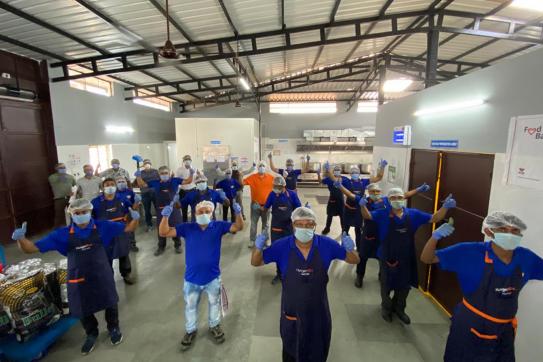When the Indian government announced a nationwide lockdown on March 24 due to the pandemic, millions of the country’s migrant laborers were suddenly left without a way to earn wages to pay for food and shelter. Facing starvation, many began arduous journeys on foot from the cities where they worked back to their families in rural hometowns.
Three days after the lockdown began, Ganesh, a successful serial entrepreneur as well as a promoter of India’s largest online grocery store Big Basket and home healthcare company Portea Medical, joined with two fellow Bangalore-based corporate executives to launch FeedMyCity. The initiative was tasked with sourcing and cooking fresh hot meals and delivering them to migrant workers every day.
The founders and volunteers could not meet face-to-face during the lockdown and resorted to Zoom and WhatsApp to organize the startup. It was through a WhatsApp group that Gita Johar, the Meyer Feldberg Professor of Business, first heard about FeedMyCity. As she watched the rapid growth of the initiative, she realized that their strategy dovetailed with her research in behavioral science.
“They were putting into practice the same principles that I would advise companies to adopt, with remarkable success at rapidly scaling up,” Johar said. “I noticed clear patterns in their actions that could be generalized to help any nonprofit organization trying to grow.”
In an article co-authored with Ganesh as well as Shilpa Madan of Virginia Tech and published in the Stanford Social Innovation Review, Johar discussed the psychological principles employed by FeedMyCity that could help spur collective action and prosocial behavior.
According to the authors, it was crucial that FeedMyCity appeal to the core identity of potential donors as responsible citizens. They used the hashtag #NoOneGoesHungry on social media, which spoke to values such as generosity and the importance of feeding the hungry. These are important tenets of Hinduism, Islam, and Sikhism, three major Indian religions.
FeedMyCity then sought to make the campaign personal to people by creating hashtags that referenced specific cities and highlighted particular individuals in need. Johar noted that they also partnered with PayTM, India’s largest mobile money network, to target specific cities and neighborhoods and conduct A-B tests to learn what messaging worked. This enabled them to respond to the market and rapidly pivot. PayTM is a popular mobile payment platform in India and donors could use it to easily and quickly make donations.
The campaign ensured that people were kept informed about the impact of their donations, which were often combined with images meant to stir the emotions of donors.
“I’m on the advisory board of non-profits,” Johar says. “And FeedMyCity did what I tell others to do: be transparent, be authentic, and share real numbers.” She observed that these principles can help increase the number of donors as well as the amount and frequency of donation. “They can also recruit volunteers to the cause because they see that they can make a difference,” she notes.
To sustain the effort, FeedMyCity also used marketing principles gleaned from startup culture such as using social media to tap celebrities and influencers to spread the word.
On the first day, FeedMyCity distributed 500 meals to workers in Bangalore, but then, as Ganesh says, the movement took on a life of it its own, with more than 400 volunteers soon signing on to help.
Within a week, they were delivering 100,000 meals a day. After a month, FeedMyCity accepted donations from 65 corporations and 60,000 individuals from 16 countries around the world, among them young students from around India who donated their pocket money.
By June, FeedMyCity had distributed a total of 4.5 million cooked meals in five cities.
“We learned a lot by trial and error, or what we call ‘startup nimbleness,’” Ganesh says. “We saw what didn’t work and moved on to things that did, pretty fast.”
FeedMyCity, which wound down its operation when India lifted its first lockdown in June, provided a sense of normalcy to a population in crisis.
In India, a cooked meal is more than just nourishment, it’s an elemental and stabilizing part of daily life.
“It’s not like in the US where ‘grab and go’ meals are common,” says Johar, who grew up in India. “That is not the culture in India, where each meal consists of cooked hot food like lentils and rice.”
Although Johar extols the sound behavioral science principles that FeedMyCity used during the lockdown, she said the success of the campaign also speaks to the importance of strong leadership and expertise.
“Ganesh and his co-founders were the right people in the right place at the right time,” she says. “They were motivated to help and had the right food-service plus technology background that enabled them to put their decades-long learnings into action for a social cause. They designed FeedMyCity from their mind and from their heart and were agile in responding to the logistical challenges of starting and growing a business during a lockdown. In the end, I see this as a story about hope during seemingly dismal times.”
And while Ganesh said FeedMyCity benefited from modern technological infrastructure such as social media and videoconferencing, he felt the entire effort was inspired and sustained by something else.
“The way that everything came together to address a pressing need --over 400 volunteers, government officials, partners, and corporate and retail donors to serve 4.5 million meals--gives me confidence to face any future calamities. I think this is a testimony to the enduring goodness of humanity,” he says.
